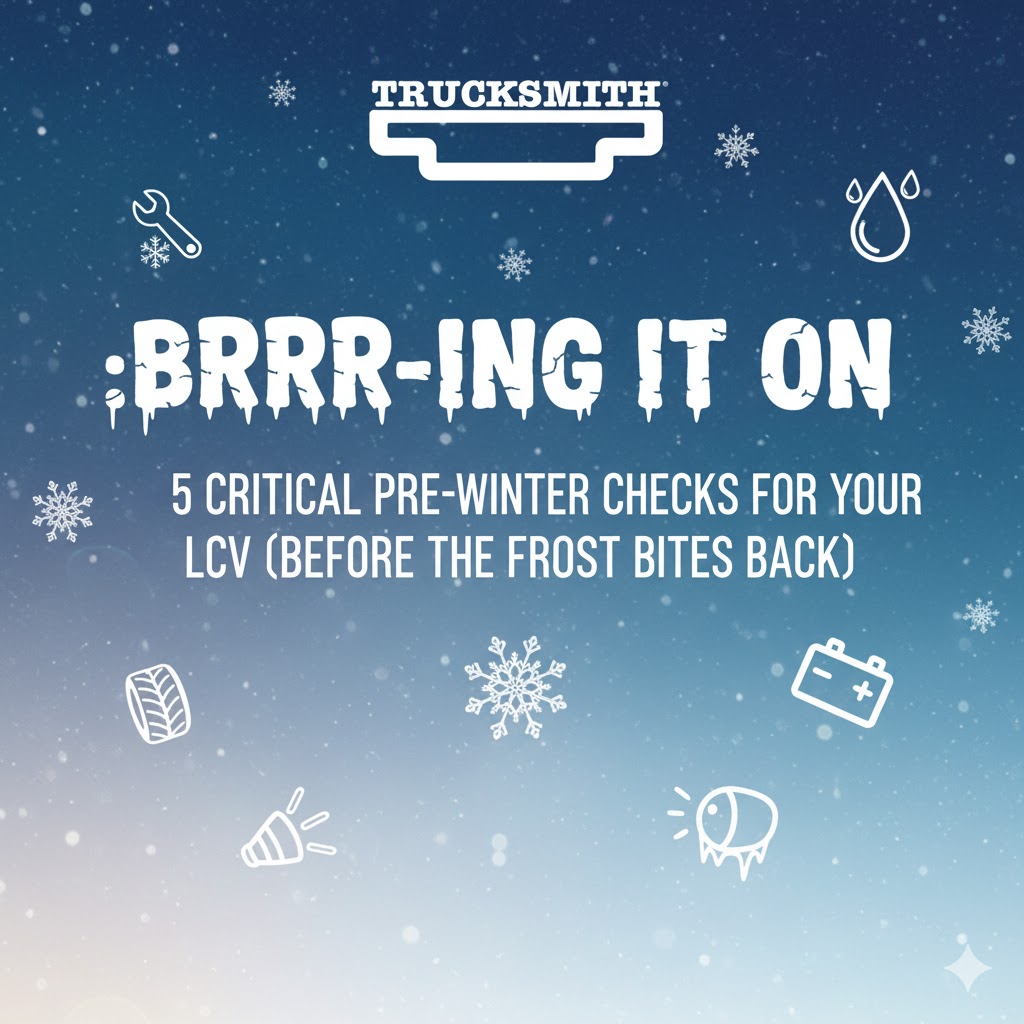The leaves are turning, the days are shrinking, and your morning coffee is suddenly being held with both hands for maximum warmth. That can only mean one thing: winter is coming.
For those of us in the Light Commercial Vehicle (LCV) world, this isn’t just about digging out the woolly hat; it’s a siren call for some serious vehicle maintenance. A breakdown is a pain in July, but in December, with sleet lashing down and a customer waiting, it’s a full-blown commercial disaster.
So, before the roads turn into a slushy ice-rink and your van decides a Tuesday morning is the perfect time to stage a protest, here are 5 Critical Pre-Winter Vehicle Checks every savvy LCV operator needs to perform now.
1. The Rubber Meets the Road (Tyres: Grip is Life)
Your tyres are your vehicle’s only contact with the road. In winter, that contact can feel as tenuous as a politician’s promise.
- Tread Depth: The legal limit is The legal tread depth limit for a 3.5-tonne vehicle is
1.6mm across the central three-quarters of the tyre’s breadth and around the entire circumference but in wet or icy conditions, the grip drastically reduces below 3mm. Don’t wait for a skid to regret putting off a replacement. Check across the full width of the tyre.
- Pressure: Cold weather causes tyre pressure to drop. Low pressure means less grip and poor fuel economy. Check them cold against the manufacturer’s recommended psi (usually found inside the driver’s door frame or in the manual).
- The Spare: When you need a spare, you really need a spare. Make sure it’s present, properly inflated, and that you have all the tools (jack, spanner) to change it.
2. The Inner Essentials (Fluids: The Lifelines of Your LCV)
A vehicle needs to stay cool in summer and not freeze solid in winter. A quick dipstick dance and reservoir inspection will save you from a major mechanical headache.
- Antifreeze/Coolant: This is number one. A 50/50 mix of antifreeze and water is generally the gold standard for preventing engine freeze and corrosion. If you’re just topping up with water, you’re diluting your protection. Get the mix checked with a hydrometer if you’re unsure. (Crucial: Only check when the engine is cold!)
- Engine Oil: Check the level and consider if you need a lower-viscosity ‘winter-grade’ oil (check your vehicle manual). Thinner oil flows better in the cold, easing start-up strain on the engine.
- Washer Fluid: Don’t be that person using plain water. It will freeze in the reservoir, potentially cracking the bottle and leaving you blind when a lorry sprays road grime onto your windscreen. Use a quality, concentrated winter-grade screenwash, effective down to at least $-15^\circ\text{C}$.
3. See & Be Seen (Lights & Wipers: Visibility is Non-Negotiable)
With darkness descending earlier and fog playing peek-a-boo, you need to ensure every beam and swipe is working perfectly.
- Lights Test: Work your way around the van: headlights (main and dipped), brake lights, indicators, side lights, and fog lights. Ask a colleague to help check the brakes. A non-functioning bulb is not just a fine risk; it’s a safety hazard.
- Wipers: Inspect the blades for splits or wear. If they’re leaving streaks or a misty film, they’re past their prime. New wiper blades are a cheap investment in your safety.
- Battery: Cold weather is a battery killer. Have your battery and charging system checked by a professional. A simple voltage test can flag a weak battery before it leaves you stranded on a freezing forecourt.
4. The Specialist Zone (Body & Ancillary Checks)
For our Trucksmith customers, your bodywork has unique needs as the temperatures drop.
- Body Seals & Doors: Check all door seals, especially on Luton and box bodies. Are they creating a good seal against the weather? Water ingress can damage cargo and cause internal freezing. A bit of silicon grease or vaseline on the rubber can help prevent doors and shutters from freezing shut.
- Load Retention Gear: Inspect any load-securing straps, nets, or shoring poles for wear or fraying. Cold weather makes materials brittle.
- Access Steps & Tail Lifts: If you have external steps or a tail lift, check all mechanisms, hinges, and hydraulics. Ensure external steps are clear of mud and grit, and that the tail lift platform (if metallic) is clean and non-slip to reduce risk when wet or icy.
5. Be Prepared (The Emergency Kit)
A proactive check isn’t just about the vehicle; it’s about the driver’s readiness for the inevitable. Stock your cab with a “Winter Warrior” kit:
- De-icer & Scraper (Obvious, but easily forgotten).
- High-Visibility Vest (Mandatory in many regions, essential if you break down).
- Warm Blanket/Extra Clothing (If you have to wait for recovery).
- Jump Leads and a fully charged Power Bank for your phone.
- Non-perishable snacks and water.
The Trucksmith Verdict:
Winter doesn’t forgive procrastination. By spending an hour on these five critical checks now, you’re not just maintaining a vehicle; you’re future-proofing your business operations and ensuring your LCV can handle everything the frost-bitten road throws at it. Stay safe, stay mobile, and let’s make this a winter of smooth, breakdown-free deliveries!






 Translate
Translate